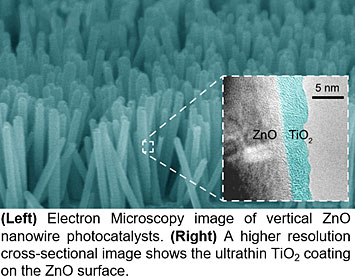Data Analytics Uncovers the Structure of Ultrathin Catalyst Coatings
June 28, 2019
What is the scientific achievement?
CFN scientists and BNL collaborators from NSLS-II and the Computational Science Initiative deduced the structure of ultrathin titania (TiO2) coatings on ZnO nanowire photocatalysts by employing new data analytic approaches to X-ray absorption near edge structure (XANES) measurements. The ultrathin, amorphous TiO2 promotes efficient charge transfer during photocatalytic water splitting while also protecting the catalyst against photocorrosion.
Why does this achievement matter?
This research implements a unique, data-driven approach to deciphering the structure of highly amorphous materials at the smallest dimensions from X-ray spectra, and lays the groundwork for understanding chemical and electronic properties.
What are the details?
Titania (TiO2) thin films are widely applied as passivation layers due to their chemical stability. However, optimizing growth conditions, which is key to achieving film quality and effectiveness, can be challenging when the coating is only a few-nanometers thick. Furthermore, the atomic-scale structure of the nominally amorphous titania coating layers, particularly when applied to nanostructured supports, can be difficult to probe. In this work, we optimize the quality of titania layers grown on ZnO nanowires using specific strategies for processing the ZnO nanowire catalyst core prior to titania coating. The best approach, a low pressure O2 plasma treatment, results in significantly more uniform titania films and a conformal coating. Characterization using X-ray absorption near edge structure (XANES) reveals the titania layer to be highly amorphous, with features in the Ti spectra significantly different from those observed for bulk TiO2 polymorphs. Analysis based on first-principles calculations suggests that the titania shell contains a substantial fraction of undercoordinated Ti4+ ions. The best match to the experimental XANES spectrum is achieved with a “glassy” TiO2 model that contains ~50% of undercoordinated Ti4+ ions, in contrast to bulk crystalline TiO2 that only contains 6-coordinated Ti4+ ions in octahedral sites.
CFN Capabilities
CFN Materials Synthesis, Theory & Computation, Proximal Probes, and Electron Microscopy facilities were used in this study.
Publication Reference
D. Yan, M. Topsakal, S. Selcuk, J. Lyons, W. Zhang, Q. Wu, I. Waluyo, E. Stavitski, K. Attenkofer, S. Yoo, M. Hybertsen, D. Lu, D. Stacchiola, M. Liu, Ultrathin Amorphous Titania on Nanowires: Optimization of Conformal Growth and Elucidation of Atomic-Scale Motifs, Nano Letters 19, 6 (2019).
https://pubs.acs.org/doi/10.1021/acs.nanolett.8b04888
DOI: 10.1021/acs.nanolett.8b04888
https://www.bnl.gov/newsroom/news.php?a=115559
http://www.newsoncards.com/science/optimizing-the-growth-of-coatings-on-nanowire-catalysts-phys-org/
Acknowledgement of Support
This research was carried out at Brookhaven National Laboratory (BNL) under Contract No. DE-SC0012704 where facilities used included those of the Center for Functional Nanomaterials (CFN) and the beamlines 8-ID ISS (Inner Shell Spectroscopy) and 23-ID-2 IOS (In situ and Operando Soft X-ray Spectroscopy) in the National Synchrotron Light Source II, U.S. Department of Energy Office of Science User Facilities, and the Scientific Data and Computing Center, a component of the BNL Computational Science Initiative. This research also used resources of the National Energy Research Scientific Computing Center (NERSC), a U.S. Department of Energy Office of Science User Facility operated under Contract No. DE-AC02-05CH11231. The effort on computation by M.T. was supported by LDRD Project at BNL (No. 16-039). The primary research contribution of J.L.L. was carried out while at CFN supported as noted above, and J.L.L. also acknowledges support from the Office of Naval Research through the Naval Research Laboratory's Basic Research Program.
2019-16705 | INT/EXT | Newsroom










